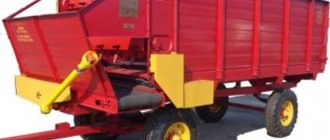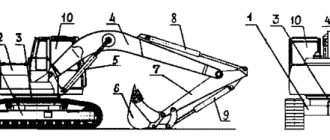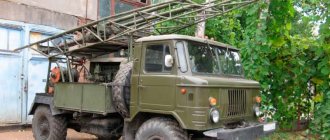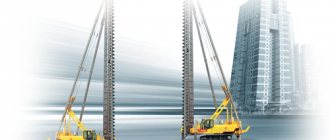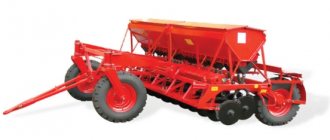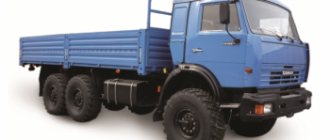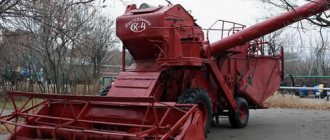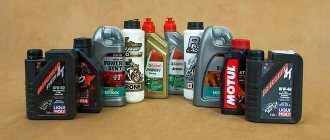Auger drilling of wells using LBU 50 type machines
This technology is used to create shallow artesian springs. Auger drilling of wells is characterized by the speed of work operations and reasonable cost. To create a high-quality water supply, it is necessary to carefully study the technology. The information presented below will help you control the actions of the contractor and select the correct associated pumping and filtration equipment.
The main feature of drilling water wells with an auger installation is clear from the specific name. This technology uses a special tool - a steel tape that wraps around the pipe. During rotation, the rock is lifted to the surface without the use of technical fluid. In the classic version, a paddle drill is used. The slope of these parts is chosen taking into account the density of the soil on a particular plot of land. To create working pressure, the weight of the created column is used.
A brief description explains the intended purpose and main consumer parameters of this technology:
- well depth – from 15 to 110 m;
- diameter – from 40 to 160 cm;
- the length of one auger rod is from 1.5 to 12 m;
- travel speed – up to 25-35 m per day (1-2 work shifts);
- power consumption – up to 10 kW/hour;
- rotation speed – from 80 to 220 rpm;
- preferred rocks are sand, peat, black soil.
Under optimal conditions, the loads on the bit are limited, so there is little wear on the equipment. Good cooling during work operations increases durability. A drill of this type is not used to penetrate rocky layers within a meter. Destroyed rocks are brought to the surface quickly. A sufficiently high speed is ensured even in the presence of pebbles and crushed stone. The clay is fixed on the blades, preventing it from being carried to the surface. If the soil viscosity is high, the cleaning tool must be lifted frequently.
Features of standard equipment:
- a chisel with three blades is reinforced with serrated plates made of a high-strength alloy;
- two-bladed modifications are created with an angle of the working tool relative to the central axis of 15-20°;
- the drill is strengthened with reinforcement and the use of cast structures;
- the auger belt is made from a steel sheet 4-7 mm thick;
- The spiral pitch is set taking into account the characteristics of the rocks (50-100% of the diameter).
In order to avoid problems when using this technology, preliminary geological surveys are necessary. If the soil composition corresponds to the definitions discussed above, dig a pit 1-1.5 m deep at a short distance from the future well. Soil is moved there during the drilling process.
Further actions:
- install machines like LBU 50 and CO 2 in the right place;
- in order not to damage the old type of installation (the mechanism was manufactured before 2000) by vibration, they dig a technological hole 40-50 cm deep, several centimeters wider than the diameter of the auger;
- a first tool with a drill is installed into the transition pipe using a clamp or threaded section;
- after deepening to the working depth, the auger is removed and cleaned if necessary;
- when the procedure takes a long time, special supports are used;
- lower the auger, attach the next element, continue drilling;
- taking into account the characteristics of the rocks, the walls are regularly strengthened with steel (concrete) pipes;
- To improve cooling, water is pumped into an artesian well through a central channel.
For auger drilling of wells with machines of the LBU 50 type to a depth of 10-15 meters, manual and portable installations are used, equipped with a power unit of relatively low power (3-5 hp). Using compact equipment, they perform work in basements and basements.
To use self-propelled specialized equipment, it is necessary to organize a passage and a site of sufficient size. With its help, wells of maximum depth with a diameter of more than 50 cm are created.
To create deep wells (200-250 m) and when passing through complex rocky rocks, rotary mechanisms are used. The drill is equipped with additional reinforcement elements. The drive provides rotational and impact movements of the working tool. They use a connection to the car engine through a gearbox, or to a powerful electric motor. This power unit is powered from the on-board network, so in some cases it is necessary to replace the standard generator.
The rock is removed to the surface with washing water, which is supplied through the central channel or into the gap between the walls. In addition to access to a suitable source, an autonomous capacity of the appropriate volume is sometimes used. Pumping equipment is added to the working kit. Taking into account the peculiarities of the technology (freezing of the process fluid at low temperatures), the restrictions on its use in winter are understandable.
The simplest method to reproduce, percussion, has been used for many hundreds of years! The fall of a heavy load from a great height can be organized using a tower. For lifting, manual and mechanized mechanisms are used.
Instead of a cone, you can create holes with a piece of pipe. In this device, a partition with a hole and a heavy ball on top are installed. This tool, in particular, is used to clean finished Abyssinian wells from contaminants accumulated during operation. If necessary, auger drilling of water wells is used in combination with other techniques.
If you use a plot of land seasonally only in the summer, you can limit yourself to an inexpensive set:
- a submersible pump is installed to lift water from the well;
- an additional stainless steel cable will serve as a safety device;
- the upper part of the structure is created using a serial head with fasteners and leads for connections to the local transport system;
- the walls of the well are reinforced with an inexpensive pipe made of low-density polyethylene.
For year-round operation, experts recommend using a caisson. This structure is installed underground. Inside there is pumping equipment, control equipment and automation. Reliable protection is provided against groundwater and contamination entering the well. At the same time, freezing of water and damage to functional components during winter is prevented.
Modern factory-made caissons are made from polymer materials that are not subject to the destructive effects of corrosion. For reinforcement, in addition to fairly thick walls, stiffening ribs are used.
Such auger drilling of water wells using LBU 50 type machines is adjusted to a pressure level determined by the project (2-3 atm). The route to the house is laid at a depth below the soil freezing level. If this is not possible, use a heating cable. The energy consumption to maintain a positive temperature will not be excessive, since the installation is turned on only in severe frosts. Additional insulation of the channel with slabs of foamed polystyrene will help reduce costs.
Such an installation of auger drilling of wells under piles at a depth of up to 20-30 meters is not capable of providing high quality natural cleaning. Such sources include:
- biological impurities;
- petrochemical products;
- agricultural fertilizers;
- waste from industrial enterprises.
Significant depth increases the cost of creating a well for piles. But at the same time, the filtration capabilities of the engineering structure are significantly improved. Such springs are highly mineralized. In addition to salts, in some cases it is necessary to remove hydrogen sulfide and iron compounds.
To specify the requirements for a cleaning installation, a new well is used for 25-30 days for watering, washing paths, and solving other technical problems. After this period is completed, samples are taken for analysis in a specialized laboratory. It is necessary to take into account the significant increase in the concentration of pollutants during floods and after heavy rains in shallow wells “on sand” per meter.
The information obtained is used to formulate the design assignment. The final values must be no worse than SanPiN standards. It is recommended to set more stringent conditions after carefully checking the composition of the contaminants:
- if you apply the “allowed” hardness level of 7 mEq/liter, you can damage the heating boiler and other equipment in a short period of time;
- even a small concentration of hydrogen sulfide will create an unpleasant odor;
- a small concentration of iron will ensure the appearance of brown streaks on the ideal surface of the plumbing fixtures.
Typical water treatment kit (equipment):
- mechanical impurities are retained at the intake site and in the main pipeline (granulated backfill, mesh and volumetric filters);
- iron is converted into an insoluble form by aeration, ozonation;
- hardness salts are removed using an ion exchange unit;
- To prepare drinking water, jugs, nozzles, sets of several cartridges and reverse osmosis technology are used.
Corrections are made taking into account the actual daily and maximum needs. A place is allocated and arranged to accommodate a set of auger drilling wells using LBU 50 type machines.
Each functional position of the project should be studied in detail. As an example, the important methods of a typical ion exchange set are listed below:
- place the equipment in a separate room (at least 5-6 sq. m) with good sound insulation to minimize noise from the regular washing/regeneration procedure;
- provide preliminary preparation to prevent damage to the backfill by organic iron and some other contaminants;
- In addition to water supply, sewerage, electrical network, ventilation and heating are installed.
Instead of the listed difficulties, a simple polyphosphate filter is used to protect the boiler (washing machine). This inexpensive technology contaminates water with chemical compounds, making it unfit for drinking. Eliminate potential problems with an electromagnetic transducer that blocks scale formation without changing the chemical composition of the water.
Drilling is part of the overall water supply project. A comprehensive solution to the problem contains:
- well construction;
- cleaning;
- good price;
- maintaining optimal pressure.
You should not forget about performing mandatory regulatory operations during use. If your own knowledge and experience is not enough on any of the listed points, turn to specialized specialists.
Auger drilling of wells: technology, equipment and stages of work
Drilling water wells is a responsible job that requires appropriate experience and equipment. It is necessary to take into account many nuances of the work itself and the characteristics of the soil.
Also, the correct choice of drilling technology is important. One of the simplest and, most importantly, cheapest is the screw method. It is quite popular and allows you to quickly make wells.
Operating principle of the screw method
This method is a rotational one, and is actually quite simple and accessible for independent use. One of the popular representatives is an ordinary garden hole drill. Another representative of manual auger devices is the ice ax. These devices are familiar and understandable to everyone.
The principle of auger drilling technology lies in the constant rotation of the blades and supply of the workings to the surface. Basically, augers for drilling water wells consist of:
- a central pipe or drill rod, along the entire length of which a steel strip is helically attached;
- tip, which inserts into the ground.
The tip cuts and loosens the soil. And the metal strip functions as a conveyor belt through which the soil excavated during the drilling process is supplied from the well.
The tip is most often made removable, so it can change depending on the type of soil. Typically used:
- three-blade chisel;
- bit with two blades;
- paddle drill
In some modifications, the tip is made permanent.
In general, this method is mainly used for making shallow wells. However, if necessary, the penetration length can exceed 50 meters. There is no need to lift the equipment during work. As they deepen, the augers are expanded with additional sections.
Auger drilling
Peculiarities
Auger drilling technology is used mainly on loose and loose soils. It ensures high speed of work - you can walk 100-200 meters in a day, and this is a pretty good indicator.
When drilling, there is one nuance - the choice of the pitch of the tape turns should be calculated in such a way that the slurry (exhausted soil) does not occupy more than half of the volume of the interturn space. Ideally, production should occupy about 30% of this volume.
This must be taken into account, because Due to rapid rotation, the screw and tip will heat up. The speed can be:
- with a tooling diameter of 200 mm – rotation speed is 100-150 rpm;
- with a diameter of 100 m - rotation speed up to 500 rpm.
Thus, the cooling of the auger occurs due to the movement of rock along the blades. Some modifications also provide water cooling. To do this, the auger for drilling wells is made on the basis of a hollow pipe through which cooling liquid can be supplied.
Advantages and disadvantages
Like other drilling methods, auger drilling has its own characteristic pros and cons.
Advantages of the method:
- simplicity;
- speed of work;
- you can make wells of large diameter, up to 150 cm;
- it is possible to drill deep holes;
- the excavated soil rises continuously to the surface, without the need to remove the equipment;
- no supply of flushing liquid is required, as, for example, with rotary technology;
- can be drilled in any direction, for example at an angle;
- a wide range of applications, in addition to drinking wells, the installations are used for exploration work, installation of pillars and piles, etc.
Flaws:
- not suitable for all types of soil - works best on loose and soft soils;
- You won't be able to make deep holes.
However, one of the main disadvantages is the inability to use on hard soils. In addition, if during work the auger encounters a large stone, this can stop the process. Thus, the auger method is inferior to others in terms of versatility, for example, the rope-impact method, which can be used almost anywhere.
On the other hand, the simplicity of the equipment and the speed of work make this method popular. It is especially in demand when work is carried out at shallow depths.
Tip
Equipment
Auger installations for drilling wells are divided into three types:
- manual;
- light mobile;
- heavy mobile.
They are intended for different tasks but work on the same principle.
Manual settings
The main advantage of such models is their light weight and compactness. Many models are equipped with a motor, which greatly facilitates the process of drilling holes in the ground.
Main characteristics of manual models:
- compactness;
- light weight - the maximum weight of the installation reaches 200 kg, while the average weighs up to 50-80 kg;
- used for drilling drinking wells, as well as other construction work.
Due to their compactness, these small-sized units can be used in any environment. You can also work indoors, such as a basement.
Light self-propelled units
These are more powerful units that are installed on the base of trucks. This makes their transportation easier. They can also use the car's chassis as a drilling platform.
Peculiarities:
- the weight of installations can reach 1 ton;
- ease of movement;
- high performance.
Naturally, such units outperform manual ones, but this is already industrial equipment.
Heavy installations
They are also mounted on heavy truck chassis. However, unlike light ones, they are already a drilling complex, because integrated with vehicle systems.
Peculiarities:
- control of the installation from the vehicle;
- the ability to drill wells of large diameters and depths;
- Autonomous operation - no additional equipment required.
Thus, installations for this type of drilling are quite widely represented on the construction market. And they allow you to perform different types of work, and are also aimed at all consumer groups - from homeowners to large industrial enterprises.
LBU drilling rigs
One of the most popular mobile units for auger drilling is the LBU 50 model. It is installed on the chassis of the following trucks:
These drilling units are highly powerful and reliable. They are used both for the manufacture of drinking wells and for general construction and exploration work.
LBU installation
The machine can carry out different types of work:
- auger drilling;
- shock-rope;
- with flushing;
- with purging;
- core.
Thus, it is quite versatile and can be used on various types of soils. Also, during the drilling process with forehead-type machines, casing pipes can be installed.
Main characteristics:
- belongs to the class of self-propelled units;
- maximum well diameter – 850 mm;
- maximum penetration depth – 200 m;
- drilling depth with augers – 50 m.
In the basic configuration, the unit is equipped with all the necessary elements for drilling operations.
CO-2 installation
This is another popular industrial model. Auger drilling of wells using type C 2 machines is used mainly for constructing piles. The installation is based on cranes or excavators.
Main characteristics of the model:
- the ability to expand the well base;
- maximum drilling depth – 30 meters;
- maximum diameter – 60 cm;
- type of drilling – auger.
CO-2 installation
Cost of equipment
The average price of drilling equipment can vary from several thousand rubles to millions. This is due to the fact that there are many models on the market aimed at different consumers.
For example:
- installation of LBU-50 - the average cost, depending on the base and configuration, varies from 3 to 4 million rubles;
- small-sized installations are much cheaper. For example, the UKB-12/25 model costs about 200 thousand, and PM-23 around 100 thousand;
- kits for manual drilling will cost even less - the average cost will be in the range of 20-30 thousand;
- a simple auger drill can be purchased for 2-3 thousand.
Among the equipment, the most popular and diverse range of small-sized units. Because for relatively little money the buyer receives a full-fledged drilling unit.
Features of the work
This technology has some features:
- The most effective method of auger penetration is considered to be drilling with equipment equipped with a central channel. In this case, air or a special water solution can be supplied to the cutter;
- If it is necessary to make deep wells, different drilling technologies are most often combined. For example, shock-rope is additionally used. This is due to the fact that the auger is not designed to pass through hard layers, as well as boulders;
- The walls of the hole become very compact during drilling, therefore, wells are most often characterized by low flow rates.
Thus, although the technology has some disadvantages, it has become widespread. This is primarily due to the speed and simple technology - which is indispensable when carrying out construction work. It is also common among homeowners, since it allows you to make wells without significant financial costs.
Video
kanalizaciyasam.ru
Drilling rigs: SBSh, SBU, impact, cable, rotary drilling
Drilling rigs (DR) are self-propelled or stationary equipment used for developing wells in the oil industry, construction and water supply. There are 4 main parameters that characterize drilling rigs - the diameter and depth of the wells, as well as direction (vertical/horizontal) and drilling speed.
Drilling rig
This article presents installations for drilling wells. We will look at their varieties, design and technical characteristics, and provide an overview of the most common equipment models.
Types of equipment for drilling wells
The main characteristic according to which well development equipment is classified is the operating principle. There are 5 main drilling methods:
- rotational;
- screw;
- percussion;
- roller-cone;
- shock-rotational.
Let us consider each of the methods, as well as the equipment used for its implementation, in more detail.
Rotary (auger) drilling machines
Rotary drilling is carried out by developing soil masses with a rotating crown, which is fed with force along the axis of the well. The crown consists of several cutting edges - “feathers”, which, in contact with the ground, chop it off, thereby going deeper down. The advantage of this method is its high speed, the disadvantage is that it can only be used in soil of medium and low hardness. When working in hard soils, the crown does not cut, but wears away the soil, which leads to accelerated wear of the cutters. There are special diamond columns, but due to the high cost of such equipment, their use is extremely limited.
Let's consider the design of a rotary drilling machine using the example of the common SBR-160 model, which is capable of developing wells with a diameter of 160-200 mm to a depth of up to 25 m. The diagram of this machine is shown in the image.
SBR-160
All self-propelled rotary drilling machines are based on a transport base - tracked or wheeled. The SBR-160 model is based on the E-652A excavator; each of its tracks is equipped with an individual drive, which significantly increases the vehicle’s maneuverability.
The working unit of the unit consists of a mast, auger and rotator. The mast is a guide structure in which the drill string (auger) feed mechanism is mounted. The screw itself can be continuous or sectional - suitable for extension.
A drilling rig rotator is a device that drives the drill string. In the SBR-160, the rotator consists of an asynchronous motor, a cartridge, a coupling, a gearbox and a hydraulic cylinder, through which speeds are switched. The technical characteristics of this model include 4 drilling speeds - 250, 160, 125 and 80 rpm.
BM-811
The following rotary drilling machines are also common in the domestic industry:
- URB-2A - mounted on the Ural-4320, ZIL-131 or AMAZ-43114 chassis. Drilling rigs of the URB-2A series are driven directly from the engine of the base transport; they are equipped with an NB-50 type pump, a KV-10 or 4VU1-5 compressor for supplying drilling fluid (depending on the model) and a BG-16 generator. The lifting capacity of the standard winch is 700 kg. Technical characteristics: drilling diameter - up to 190 mm, depth - up to 100 m;
- Atlas Copco DM-45 and DM-50 are crawler-mounted units that develop wells with a diameter of 150-230 mm to a depth of up to 53 meters, and are capable of developing a hydraulic force at the bottom of up to 200 kN.
- SBR-160A and SBR-160B are tracked rigs designed for drilling rocks with a strength coefficient of 1-6. Drilling diameters - 160, 180 and 200 mm. The models differ in technical performance: for SBR-160A it is 60 m/h, for SBR-160B it is 30 m/h.
Among the equipment from foreign manufacturers, we highlight Sandvik rotary drilling rigs, produced by the Swedish concern of the same name. The company's product range includes units for developing wells with a depth of 27-45 m and a diameter of up to 311 mm.
Auger drilling of wells using LBU 50 type machines (video)
Impact Drilling Machines
Percussion drilling rigs develop a well by briefly impacting the bottom of the well with a special tool that performs reciprocating movements. Depending on the principle of operation, all drilling rigs of this type are divided into 3 types:
- Impact-rope drilling machines.
Their design does not imply the presence of axial force when feeding the working tool - the striker falls to the bottom of the well under its own weight. Such equipment has a fairly low productivity, but at the same time it is extremely effective in the development of brittle rocks.
The working tool of such machines weighs 1-3 tons, it is suspended on a winch and raised by means of a crank mechanism to a height of 1-2 meters above the face. During the development process, water is poured into the bottom of the well, softening the rock. The destroyed soil is periodically removed using a bailer.
BS-3
Installations for percussion-rope drilling can be either large-sized, tracked (BS-3) or wheeled (BZ-6), or compact (prefabricated type) for developing water wells. A common disadvantage of all units is low productivity, since the speed of free fall of the working tool directly depends on the force of gravity and the number of blows cannot be increased above 50-60 pcs/min.
- Roller drilling machines.
In such units, the working tool is a roller bit, which carries out crushing and shearing of the rock. The drill string on which the bit is attached is subjected not only to reciprocating motion with great force relative to the bottom of the hole, but also to rotational motion.
Roller bit
Such installations are used for drilling all types of soils - from soft to especially hard (including rocks); they are capable of developing wells with a diameter of 72-400 mm. Among domestic equipment, we highlight the SBSh-200 machine (depth - 30 m, diameter 190-243 mm) and the SBSh-250 machine (depth - 40 m, diameter - 214-270 mm). When developing quarries, the BTS 150 drilling rig based on the T-10M crawler tractor is most often used.
- Rotary percussion drilling machines
Rotary impact drilling installations differ from percussion-rope and roller-cone units in that when developing a well, their working tool rotates not only in breaks between impacts, but continuously. In this case, the face deepens beyond the entry of the bit into the ground at the moment of impact, and rotation ensures that the bottom of the well is cleared of mined-out rock.
The main features of this type of equipment are low torque and axial force, with a high impact load. Rotary percussion drilling demonstrates maximum productivity when working on particularly hard and abrasive rocks.
SBU-125
Among the domestically produced equipment, the most common are the SBU-125 series units, capable of developing vertical and inclined wells with a diameter of up to 125 mm to a depth of 22 meters. All SBU-125 models are equipped on the basis of the UP-3 tracked coal loading machine.
Core drilling machines
Core drilling rigs are most often used in research and construction work. Their main difference from auger and impact equipment is that soil excavation is not carried out along the entire perimeter of the well, but only along the radius of the core tool, which is a round pipe with carbide cutting teeth welded to the end.
During operation, the internal cavity of the core projectile is filled with cut out soil, after which the projectile is raised to the surface and its contents are removed. This principle of operation makes it possible to obtain solid rock necessary for geodetic tests.
SKB-4100
Also, all units for drilling holes in monolithic structures made of reinforced concrete operate according to the core principle. Their working tools are equipped with special diamond cutters that effectively cut through materials of increased hardness.
Among the common equipment for developing geological exploration wells, we highlight the SKB-4100 machine (diameter up to 46 mm, depth up to 700 m) and Atlas Copco C5 (50 mm, up to 1000 m).
Home page » Drilling rigs
How auger well drilling is performed
Drilling a well with an auger
Auger drilling is very often used to create water wells. The process of such drilling consists of crushing and sampling the soil. An auger is used as a tool for drilling wells. The hard rock is destroyed during the work with a special cutter and then removed using an auger to the ground surface. The article discusses the issues of do-it-yourself drilling.
Types of well drilling
You can drill a water well on a personal plot or summer cottage using one of the following types:
The listed drilling technologies differ from each other in the methods of rock destruction and methods of extracting soil structures from the shaft. In each case, certain equipment is used, which affects the quality differently, which determines the final price of the work. Each method of the process can be seen in the video. This article discusses in more detail the issues of drilling wells using the auger method, and the features that an auger well pump has.
What is auger drilling
The essence of the process is to destroy the rock with a chisel, followed by its delivery to the surface using an auger screw that rotates at high frequency. This method is used in the presence of rock of low hardness and without flushing the well. Features of the process:
- When auger drilling, a high speed of work is ensured without grinding and abrasion of the rock that has already been separated from the bottom.
- The face is cleaned continuously, simultaneously with the destruction of the rock.
- When separated from the face, the rock is fed to a screw auger, which rotates at high speed. The centrifugal forces that arise press it against the walls, and a constantly moving screw belt lifts the rock upward. In this case, part of the rock is rubbed into the walls using the flange of the tape.
- With this process, the face is well cleaned of destroyed rock. This ensures high drilling speeds up to category IV rocks in terms of drillability.
- High mechanical speed is ensured when passing through weak cemented deposits of small pebbles and crushed stone. This is due to the fact that the latter are not destroyed, but are brought to the surface entirely.
- The auger conveyor does not work well in viscous clays that stick to the augers and prevent the transportation of drilled rock.
- The bit and augers are cooled due to their rapid penetration into soft rocks with constantly changing temperatures.
- Auger drilling can be done to depths from 1.5 to 80 meters.
- This process is used for drilling exploratory and engineering-geological wells, during hydrogeological studies in combination with other methods.
Advantages of auger drilling in soft rocks:
- High deepening speed.
- Rock transportation is carried out without lifting the tool, continuously.
- Drilling can be done without flushing.
Disadvantages of the process:
- Relatively shallow drilling depth.
- Rotating a heavy screw column requires more power.
The design of the auger drilling tool includes:
- Bit.
- Auger drill collar.
- Column of augers.
Well drilling tool
Advice: To increase the service life of the bit, it must be reinforced with carbide cutters. The diameter of the bit must be 15-20 mm larger than the diameter of the auger for free rotation of the auger column in the well, due to the fact that a slurry crust forms on its walls.
The most popular are two- and three-blade chisels. The body of a three-bladed bit is made of steel casting with serrated blades inclined along a helix. Carbide octagonal cutters reinforce the blades.
Machines for screw installations
The rotation of the working tool on the screw installation is carried out by special machines. Thus, auger drilling of wells using machines of the LBU 50 type is provided by a movable rotator, which eliminates the use of spindle and rotor type devices. This is necessary to provide high torque and carry out translational axial movement of the screws. To ensure high speed, machines must be powerful, highly productive and have sufficient mobility.
To do this, they are often installed on the chassis of tractors or cars, as shown in the photo.
Well drilling rig
Auger drilling of wells using CO 2 type machines is carried out with a mounted working body. The CO 2 installation is installed on an E-1252 type excavator. On it:
- Using a hinged device, a stand is attached to which a hinged working element is movably connected, including a carriage with an electric drive.
- A telescopic auger drill string with a drilling tool and a cleaner is installed on the shaft of the device.
- The column consists of two telescopic sections; auger blades are mounted on the bottom.
- The reamer or auger with a drill bit is pinned to the bottom section of the column.
The purpose of the drill bit, which has the shape of a three-blade bit that rotates, is to destroy the soil in the bottom and feed it to the drill string auger. For different soils, a set of crowns is included with the installation.
Tip: To hold the drill string when switching telescopic rods, you need to use an interception lever from two levers.
With this device you can drill to a depth of up to 70 meters, and the use of an expansion tool allows you to increase its diameter to two meters.
Screw pumps for wells
Auger pumps for wells are widely used, operating on the same principle as drilling installations - supplying water to the surface using an auger.
Screw pump for wells
A downhole auger pump, unlike others, can pump liquids containing abrasive particles and aggressive chemical elements. Work equally well in vertical and horizontal positions. They are distinguished by their reliability and simplicity of design, the price of the units is acceptable for use on any site.
Screw submersible pumps for wells have several important features:
- Convenient design. The attached instructions allow you to operate the device without any problems and, if necessary, carry out repairs.
- During repairs, the pump can be easily dismantled; all wear parts can be easily replaced with new ones.
- The design of the product is carefully worked out. There is no possibility of deposits on the suction body, and the suction pipe can be rotated 90 degrees.
- There is no vibration, which leads to increased service life.
moikolodets.ru
LBU-50
About the company » Drilling rigs and spare parts » Drilling rigs with a movable rotator » LBU-50
Multi-purpose drilling rig LBU-50 with a mechanical drive of a movable rotator is designed for drilling wells for various purposes when performing construction work, technical, hydrogeological and water supply wells, during engineering surveys and geological exploration work.
The LBU-50 drive is carried out from the transport base engine through the power take-off (PTO). LBU-50 is mounted on the chassis of various trucks, including AMUR (ZIL-131), URAL, KamAZ.
- rotary auger and percussion-rope drilling (using a balancing mechanism with free projectile release) of engineering, hydrogeological and technical wells
- drilling wells during the construction of piles and sheet pilings (including equal augers)
- Drilling holes in a rotary manner (flights) using auger drills with diameters of 650, 850, 850 mm
- rotary core and coreless drilling of geological exploration, hydro- and engineering-geological, technical wells using flushing fluid
- rotary core “dry” (without using a cleaning agent)
- rotary core and coreless drilling of wells for various purposes with bottom hole cleaning using a stream of compressed air
- rotary impact drilling of wells with a diameter of up to 550 mm using submersible pneumatic impact machines (provided that they are equipped with the appropriate compressor equipment).
| vendor code | LBU-50 |
| Feed stroke, m | 3,25 — 3,9* |
| Feed force, kgf | |
| - up | 12000 |
| - down | 4000 |
| Spindle speed, rpm | 14-101; 14-220* |
| Torque, kgm | 2000 |
| Winch load capacity, kgf | 2500 |
| Conditional drilling depth, m | |
| — augers | 60 |
| - auger drill | 25 |
| - auger drill sliding along the rods | 16 |
| - with flushing | 200 |
| — with purging | 100** |
| Drilling diameter, max., mm | |
| — augers | 500 |
| - auger drill | 850 |
| — with flushing (final) | 190,5 |
| — with purging (final) | 190,5 |
| — down-the-hole hammers | up to 550 |
Drilling rig LBU-50 is the leader of Russian drilling production
The Russian company Geomash has earned credibility and popularity thanks to its reliable instruments for drilling wells. The head office of the plant is based in Moscow, and production lines are in the Kursk region.
General parameters of LBU-50 drilling rigs
The drilling machine is equipped with a mechanical drive. The equipment is mainly used for wells:
- used in the construction of a wide variety of objects;
- having a technical purpose;
- geological developments;
- designed for water intake.
The technique has a list of significant advantages:
- from the very beginning of work, the soil breaking tool experiences enormous pressure from a special device;
- during drilling, the rotator can be tilted away from the hole being made due to its unique configuration;
- the equipment is designed for installation of casing columns;
- The machine allows you to drill holes using the cable-percussion method, while simultaneously using a winch.
A minor disadvantage of drilling equipment is that it is driven by a motor from the transport base.
The LBU 50 drilling rig has the following serial models: 05, 07, 08, 10, 20.
The following can be used as optimal mobile bases:
Photo of the LBU-50 drilling rig on a KamAZ chassis
With the drilling system you can do the following:
- make holes with augers up to 500 mm in size;
- form pits up to 850 mm;
- make wells using the rotary impact method with a diameter of 550 mm;
- drill holes using the flushing or blowing method with a diameter of up to 490 mm;
- with the dry method, the hole size reaches up to 172 mm.
Design features
The machine is equipped with a mechanical drive device and a rotator, and the feed structure is driven by a mast, which is the guiding force.
The mast has a transport and working position. They are changed by hydraulic cylinders. The mast is also equipped with a single string rig, which is located at the top.
To provide mobile drilling rigs with stability and balance, the machine is equipped with hydraulic jacks.
The drilling device has powerful headlights, thanks to which it remains operational in the dark. The entire system is controlled using reliable remote controls, which are located on the mast structure and on the frame. It is also important to create comfortable working conditions for the installation driver. For these purposes, the structure is equipped with a convenient removable platform.
Drawing of the LBU-50 drilling rig winch
Basic equipment
In the basic version, the installation is equipped with the following equipment:
| Device | Unit measurements | Data |
| Drills with augers | mm | 135, 180, 230, 300, 330, 350, 400, 500 |
| Equal augers | mm | 200, 320, 470 |
| Augers with removable chisel | mm | 300 |
| Augers with sliding chisel | mm | 350 |
| Breaking Projectiles | mm | 121 |
| Set for shock-rope work: | ||
| — blow.-driving glass | mm | 89 |
| - impact-driving cartridge | mm | 108 |
| - casing system | mm | 127 |
| Dry working kit | ||
| Column device | model | SKS-127 |
| Blowing kit | ||
| Device for flushing work | ||
| Devices for continuous technology | ||
| Boers | mm | 650, 850 |
| Sliding augers | mm | 650, 850 |
| Pneumatic plunge hammers | mm | 550 |
Additional equipment for forming well systems
The installation is designed, if necessary, to work with the following equipment:
| Tool | Model |
| Pump | NB-50 |
| Compressors | PK-50 |
| Generators for welding | 500 |
| Two hydraulic jacks | |
| Winch | |
| Balance | |
| Desktop | |
| Casing table |
Modifications
The technology for forming wells has several modifications:
| Equipment | 20 and 05 | 07 | 08 | 10 |
| Winch | + | + | + | + |
| Balance | + | — | — | — |
| Pump | — | + | — | — |
| Compressor | — | — | + | — |
| Generator | — | + | Optional | + |
| Front jacks | — | + | + | + |
| Rear jacks | + | + | + | + |
| Additional rear jacks | — | + | + | + |
| Loading platform | + | + | + | + |
| Driver's platform | — | + | + | + |
| Swivel | — | + | + | — |
| Clamping table | — | + | Optional | — |
| Desktop | — | Optional | + | + |
| The basis | ZIL, URAL, KAMAZ | KamAZ | KamAZ | KamAZ |
Photo of modification LBU-50-08
Technical characteristics of the LBU-50 drilling rig are presented in the table:
| Characteristics | Unit measurements | Indicators |
| Drive power | kW | 95-165 (depending on the chassis) |
| Innings | m | 3,25-3,9* |
| Top feed | kgf | 12000 |
| Bottom feed | kgf | 4000 |
| Frequency spindle | rpm | 14-101, 14-220* |
| Torque | kgm | 2000 |
| Load capacity of winch device | kgf | 2500 |
| Well depth | m | 16-200 (depending on drilling method) |
| Diameter of formed holes | mm | 190.5-850 (depending on drilling method) |
* - depends on the installation model
You might be interested in: The best modular parquet in Moscow
